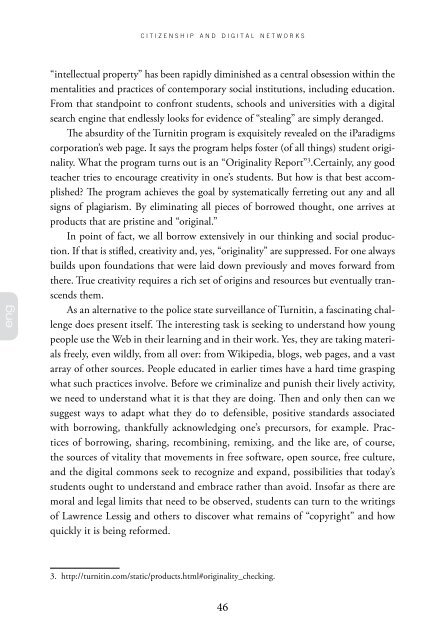Sergio Amadeu da Silveira - Cidadania e Redes Digitais
Sergio Amadeu da Silveira - Cidadania e Redes Digitais
Sergio Amadeu da Silveira - Cidadania e Redes Digitais
You also want an ePaper? Increase the reach of your titles
YUMPU automatically turns print PDFs into web optimized ePapers that Google loves.
eng<br />
c i t i z e n s h i p a n d d i g i t a l n e t w o r k s<br />
“intellectual property” has been rapidly diminished as a central obsession within the<br />
mentalities and practices of contemporary social institutions, including education.<br />
From that standpoint to confront students, schools and universities with a digital<br />
search engine that endlessly looks for evidence of “stealing” are simply deranged.<br />
The absurdity of the Turnitin program is exquisitely revealed on the iParadigms<br />
corporation’s web page. It says the program helps foster (of all things) student originality.<br />
What the program turns out is an “Originality Report” 3 .Certainly, any good<br />
teacher tries to encourage creativity in one’s students. But how is that best accomplished?<br />
The program achieves the goal by systematically ferreting out any and all<br />
signs of plagiarism. By eliminating all pieces of borrowed thought, one arrives at<br />
products that are pristine and “original.”<br />
In point of fact, we all borrow extensively in our thinking and social production.<br />
If that is stifled, creativity and, yes, “originality” are suppressed. For one always<br />
builds upon foun<strong>da</strong>tions that were laid down previously and moves forward from<br />
there. True creativity requires a rich set of origins and resources but eventually transcends<br />
them.<br />
As an alternative to the police state surveillance of Turnitin, a fascinating challenge<br />
does present itself. The interesting task is seeking to understand how young<br />
people use the Web in their learning and in their work. Yes, they are taking materials<br />
freely, even wildly, from all over: from Wikipedia, blogs, web pages, and a vast<br />
array of other sources. People educated in earlier times have a hard time grasping<br />
what such practices involve. Before we criminalize and punish their lively activity,<br />
we need to understand what it is that they are doing. Then and only then can we<br />
suggest ways to a<strong>da</strong>pt what they do to defensible, positive stan<strong>da</strong>rds associated<br />
with borrowing, thankfully acknowledging one’s precursors, for example. Practices<br />
of borrowing, sharing, recombining, remixing, and the like are, of course,<br />
the sources of vitality that movements in free software, open source, free culture,<br />
and the digital commons seek to recognize and expand, possibilities that to<strong>da</strong>y’s<br />
students ought to understand and embrace rather than avoid. Insofar as there are<br />
moral and legal limits that need to be observed, students can turn to the writings<br />
of Lawrence Lessig and others to discover what remains of “copyright” and how<br />
quickly it is being reformed.<br />
3. http://turnitin.com/static/products.html#originality_checking.<br />
46


